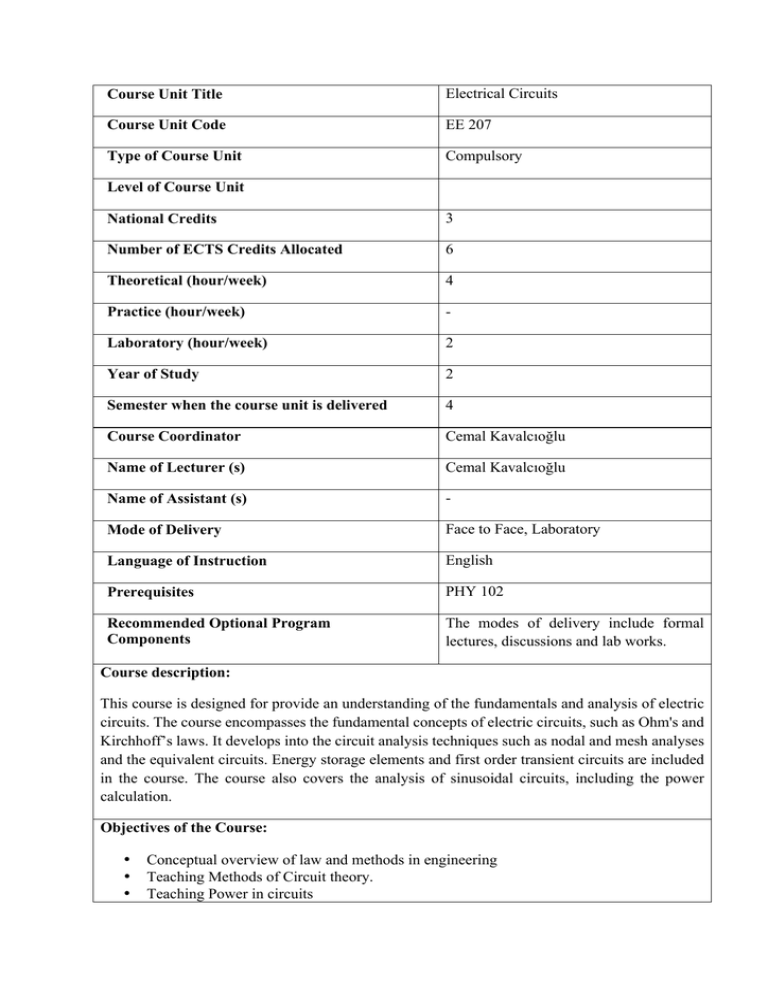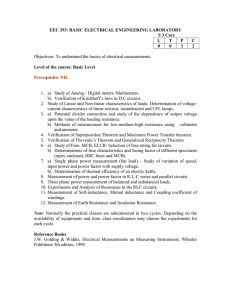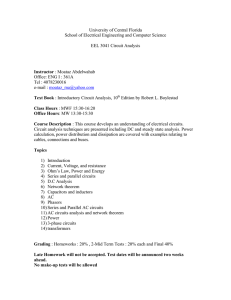Course Unit Title Electrical Circuits Course Unit Code EE 207 Type
advertisement

Course Unit Title Electrical Circuits Course Unit Code EE 207 Type of Course Unit Compulsory Level of Course Unit National Credits 3 Number of ECTS Credits Allocated 6 Theoretical (hour/week) 4 Practice (hour/week) - Laboratory (hour/week) 2 Year of Study 2 Semester when the course unit is delivered 4 Course Coordinator Cemal Kavalcıoğlu Name of Lecturer (s) Cemal Kavalcıoğlu Name of Assistant (s) - Mode of Delivery Face to Face, Laboratory Language of Instruction English Prerequisites PHY 102 Recommended Optional Program Components The modes of delivery include formal lectures, discussions and lab works. Course description: This course is designed for provide an understanding of the fundamentals and analysis of electric circuits. The course encompasses the fundamental concepts of electric circuits, such as Ohm's and Kirchhoff’s laws. It develops into the circuit analysis techniques such as nodal and mesh analyses and the equivalent circuits. Energy storage elements and first order transient circuits are included in the course. The course also covers the analysis of sinusoidal circuits, including the power calculation. Objectives of the Course: • • • Conceptual overview of law and methods in engineering Teaching Methods of Circuit theory. Teaching Power in circuits Learning Outcomes At the end of the course the student should be able to 1 2 3 4 Analyze simple DC circuits using systemic analysis techniques (basic law). Apply Thevenin’s theorem, Norton’s theorem and the superposition theorem to aid in circuit analysis. Explain AC steady-state circuit concepts (impedance, reactance, etc.) and perform AC steady state analysis. Perform DC and AC steady-state power calculations Assessment 1, 2, 5 1, 2, 5 1, 2, 5 1, 2, 5 Assessment Methods: 1. Written Exam, 2. Assignment, 3. Project/Report, 4. Presentation, 5. Lab. Work Course’s Contribution to Program CL 1 Apply knowledge of mathematics, natural science with relevant to life science and multidisciplinary context of engineering science. 5 2 Analyze, design and conduct experiments, as well as to analyze and interpret data. 4 3 Design a system, component or process to meet desired needs within realistic constraints such as economic, environmental, social, political, ethical, health and safety, manufacturability and sustainability. 4 4 Function on multidisciplinary teams. 4 5 Control in design work, by using simulation, modelling and tests and integration in a problem solving oriented way. 4 6 Display an understanding of professional and ethical responsibility. 3 7 Communicate effectively aware of the non-technical effects of engineering. 2 8 Search technical literature and other information sources. 1 9 Recognize of the need for, and an ability to engage in life-long learning. 2 10 Exhibit a knowledge of contemporary issues. 2 11 Use the techniques, skills and modern engineering tools necessary for engineering practice to develop marketable products for the global market. 3 CL: Contribution Level (1: Very Low, 2: Low, 3: Moderate, 4: High, 5: Very High) Course Contents Week Chapter Topics 1 • Introduction 2 • Definitions and Units 3 • Kirchhoff’s Laws. 4 • Kirchhoff’s Laws 5 • Nodal Analysis, Mesh Analysis 6 • Nodal Analysis, Mesh Analysis contd. 7 • Superposition Theorem 8 • Midterm 9 • Source Transformation 10 • Source Transformation 11 • Thevenin’s and Norton’s Theorem 12 • Thevenin’s and Norton’s Theorem contd. 13 • Energy Storage Elements 14 • Energy storage Elements contd. 15 • Sinusoidally Forcing Function • FINAL Exam Final Recommended Sources Textbook: • James W. Nilsson, Susan A. Riedel “ELECTRIC CIRCUITS” Prentice Hall, Seventh Edition. Supplementary Course Material Assessment Attendance 5% Laboratory 15 % Less than 25% class attendance results in NA grade Midterm Exam 30 % Written Exam Final Exam 50 % Written Exam Total 100 % Assessment Criteria Final grades are determined according to the Near East University Academic Regulations for Undergraduate Studies Course Policies • Attendance is Compulsory. Every student is expected to attend the class regularly on time. • Students may use calculators during the exam. • Cheating will not be tolerated. Cheating will be penalized according to the Near East University General Student Discipline Regulations ECTS allocated based on Student Workload Number Duration (hour) Total Workload(hour) Course duration in class (including Exam weeks) 16 4 64 Labs and Tutorials 5 10 10 Assignment - - - Project/Presentation/Report - - - E-learning activities - - - Quizzes - - - Midterm Examination 1 15 15 Final Examination 1 15 15 Self-Study 14 3 42 Activities Total Workload 176 Total Workload/30(h) 5.59 ECTS Credit of the Course 6

